Adjacent to the U.S. state of Massachusetts, Buzzards Bay runs approximately 28 miles by 8 miles. In this Atlantic bay, numerous visitors enjoy the saltwater adventures of fishing, swimming, boating, and more. But like most saltwater bodies, the habitat raises concerns for dangerous marine life and potential shark attacks. If you’re headed to the bay for pleasure or work, you should probably find out what you’re looking at. How many and which sharks in Buzzards Bay could you spot? Are they dangerous? What should you do if you see one?
Where is Buzzards Bay?

Come for the sunsets over Buzzards Bay on Old Silver Beach, Cape Cod, and avoid the sharks!
©ayaDadara/Shutterstock.com
Adjacent to the state of Massachusetts in the Atlantic Ocean, Buzzards Bay boasts some glorious beaches. The bay itself measures 28 miles long and 8 miles wide and welcomes watersports of all kinds. Fishers, boaters, and tourists of all types love this bay that connects to Cape Cod by the Cape Cod Canal. It’s been designated to the National Estuary Program, as well, helping to maintain its health, cleanliness, and preventing over development of the area.
Significant ports and port cities along the bay or connected include Cape Cod, Bristol, Plymouth, and New Bedford. The latter was once the most successful whaling port in the world, though the practice has ended here. Now, it’s the most productive fishing port in the nation.
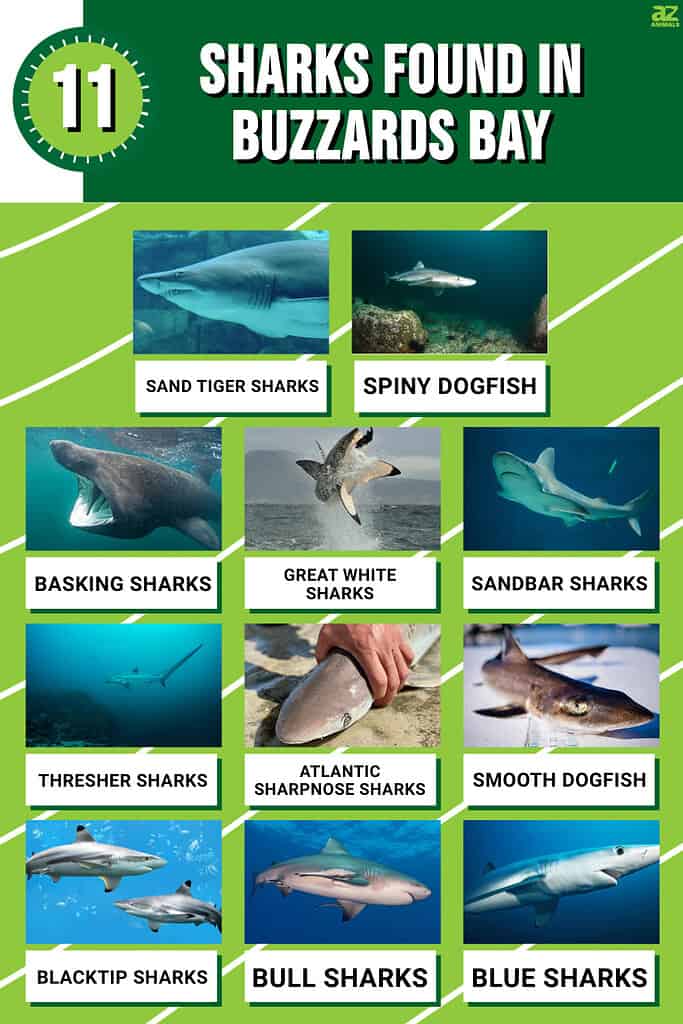
Which Shark Species Live in Buzzards Bay?

Not all sharks are as terrifying as the reputation the Great White Shark holds. In fact, even this shark in Buzzards Bay isn’t as aggressive as you might think.
©Martin Prochazkacz/Shutterstock.com
More than eleven species of sharks may be found in Buzzards Bay. Which species swim here at any given time depends on the season. Some live here year-round, while others migrate in a for a safe haven for breeding or feeding. Others make their way in during migration.
While visiting, you may spot any of these sharks in Buzzards Bay:
- Sand tiger sharks
- Spiny dogfish
- Basking sharks
- Great white sharks
- Sandbar sharks
- Thresher sharks
- Smooth dogfish
- Blacktip sharks
- Bull sharks
- Blue sharks
1. Sand Tiger Sharks
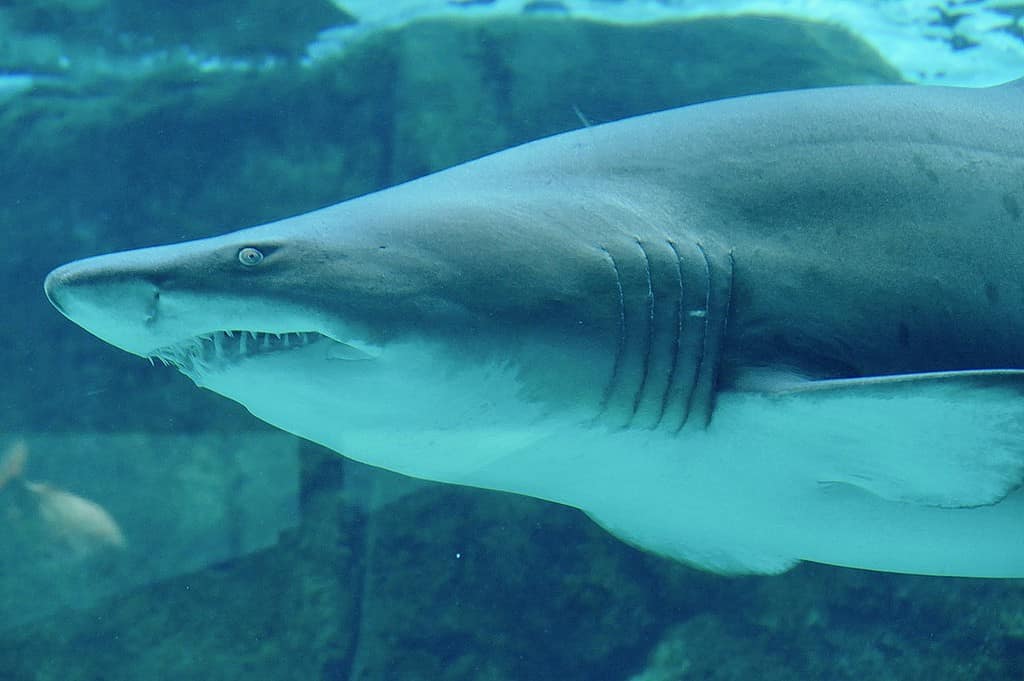
Those teeth sure are intimidating! But, thankfully, sand
tiger
sharks in Buzzards Bay aren’t known to attack humans fatally.
©Bernard DUPONT from FRANCE / CC BY-SA 2.0 – License
Known as sand tiger, gray nurse, spotted ragged-tooth, or blue-nurse sand tiger sharks, these fish may be found in Buzzards Bay. The sand tiger shark typically inhabits subtropical and temperate waters throughout the world, along the continental shelf near sandy shorelines. They may also be found in submerged reefs as deep as 627 feet.
The names for the shark present a misnomer: sand tigers are neither related to tiger nor nurse sharks. These long sharks, measuring up to 7 to 8 feet on average, or 10.5 feet on the long end, are classed as Critically Endangered on the International Union for Conservation Nature Red List.
The relatively slow-moving, placid sharks are not known for human fatalities (none have been recorded). Sand tiger sharks have sharp, pointy heads and bulky bodies in gray. Reddish-brown spots dot their backs. Shivers (groups) of sang tiger sharks have been seen hunting large schools of fish together. The unique species also eats squid, crustaceans, skates, and other sharks. Additionally, they are one of the few species of sharks that can gulp air from the surface. This means they may stay suspended in water columns with little effort.
They aren’t terribly common in Buzzards Bay and have not attacked humans here, but it’s still a good idea to keep an eye out for them and avoid anything that looks like these moderately large sharks.
2. Spiny Dogfish
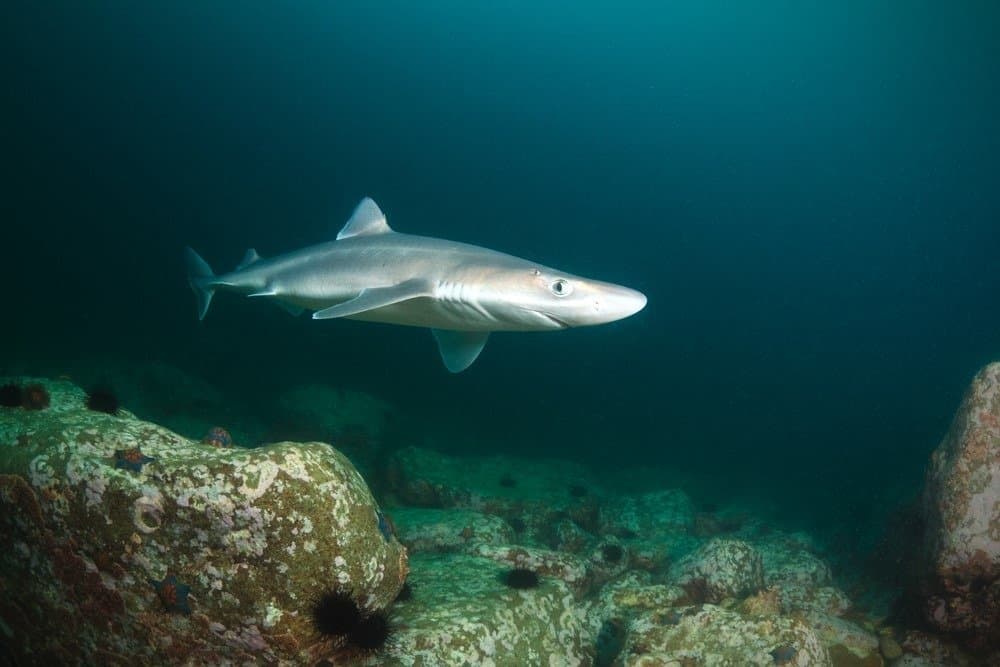
Small sharks, spiny dogfish swim in Buzzards Bay, seen frequently by humans.
©Boris Pamikov/Shutterstock.com
Spiny dogfish have slim bodies and narrow, pointy snouts. They often bear white spots on their gray bodies, with white undersides. Two dorsal fins with ungrooved spines also help to demarcate these fish from other dogfish, such as the smooth dogfish. Males grow up to 3.3 feet long, while females grow up to 4 feet in length.
While not the most common sharks in Buzzards Bay, spiny dogfish may frequently be spotted by folks in the bay. They range across much of the North Atlantic and frequently make their way into the bay as they migrate and seek food. They sometimes hang out in deeper waters but often rest at the bottom of inshore waters in large schools.
These sharks prefer crustaceans to other fish and marine life and are small enough that they don’t really threaten humans. They are, however, still sharks and wild animals. Avoid approaching one if you see it. They could still hurt you.
3. Basking Sharks

In many ways, basking sharks feel more like whales. The massive fish eat plankton via filters in their gills and tend to leave humans in Buzzards Bay alone.
©Martin Prochazkacz/Shutterstock.com
The second largest shark species in the world next to whale sharks, basking sharks may reach 5 tons in weight and 32 feet in length. These monstrous fish seem scary if you spot them out on open water, but they’re considered harmless to humans. Basking sharks primarily feed on plankton and filter this food through their gills while they swim.
These sharks visit Buzzards Bay during the summer months. Often, folks on whale watching tours spot them on their journey, as they tend toward deeper waters rather than the close coastline.
Unfortunately, basking sharks fall on the vulnerable species list, due to overfishing. Sightings of these beautiful sharks are less and less frequent because of it. They come in grayish-brown, sometimes mottled. They have a crescent-shaped caudal fin with a strong lateral keel.
4. Great White Sharks

Though infrequently seen, great white sharks do sometimes make their way into Buzzards Bay.
©Sergey Uryadnikov/Shutterstock.com
The most notorious species of shark, the Great White, occasionally makes its way into Buzzards Bay. The apex predators travel long distances to feed here, so they may be seen somewhat regularly during specific months of migration.
These torpedo-shaped fish are seen as ruthless killers, partially thanks to movies like “Jaws” and the shark attack reports. However, the fish are intelligent and curious creatures that mainly feed on smaller marine animals like seals and fish. Occasionally, great white shark attacks do occur, but they’re less common than other species’ attacks.
Since great white sharks may make their way into Buzzards Bay during warmer months, keep an eye out for them. Though they don’t often attack humans, they should be avoided. It’s thought that the fish come to the bay in search of the many seals populating the water and, occasionally, humans may get in their way.
5. Sandbar Sharks
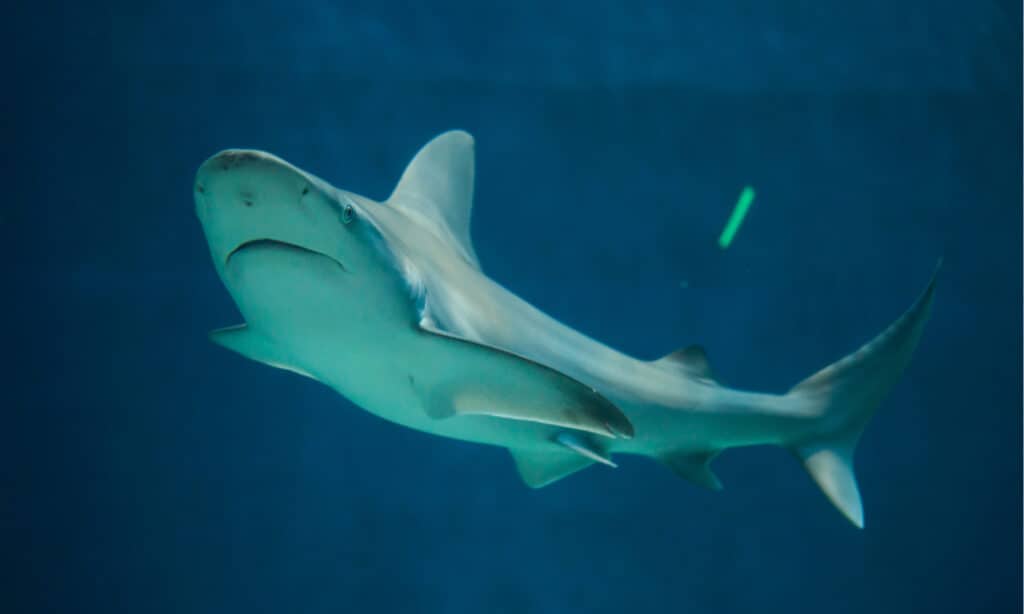
Sandbar sharks appear in Buzzards Bay commonly.
©Vladimir Wrangel/Shutterstock.com
The most common shark species found in Buzzards Bay, sandbar sharks grow between 6 and 8 feet long. Thankfully, these fish are docile, since they prefer swimming in shallow waters in the bay, near beaches. Rarely aggressive towards humans, these sharks should still be viewed with caution and should not be approached. They can weigh up to 300 pounds and could still do some damage if threatened.
Sandbar sharks come in gray or brown, with tall first and second dorsal fins. They prefer hanging out in Buzzards Bay during warmer months, when swimmers are out, so exercise caution and keep away, particularly if you see schools of smaller fish or squid. They love dinging on these marine creatures.
6. Thresher Sharks
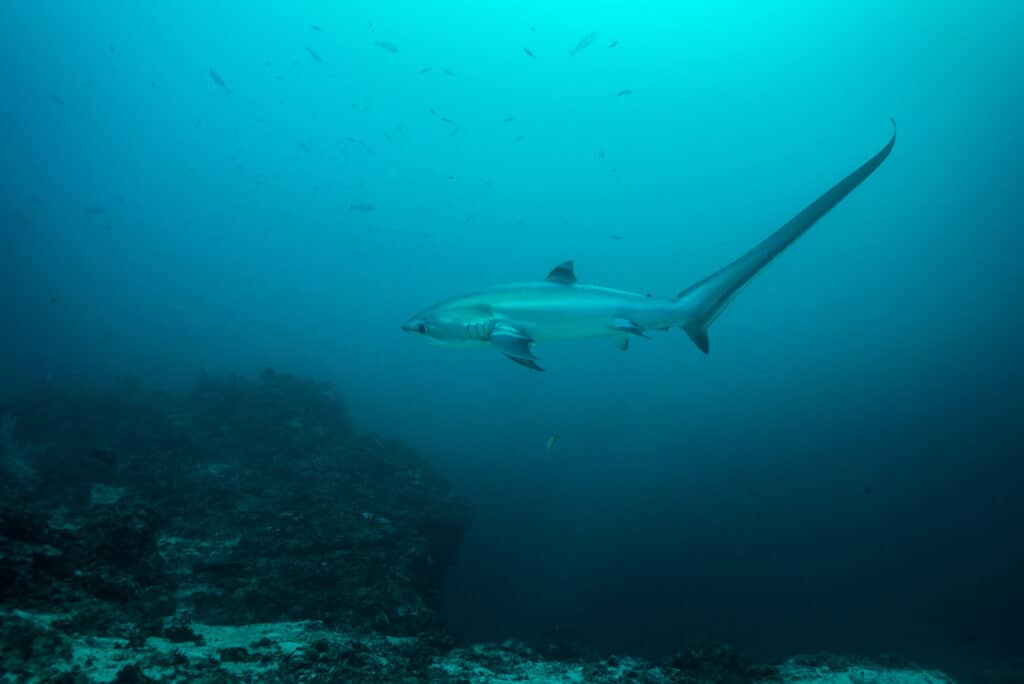
While they likely won’t intentionally attack humans in Buzzards Bay, thresher sharks can still hurt humans with those whip-like tails.
©bearacreative/Shutterstock.com
With long, whip-like tails, thresher sharks are easy to identify in Buzzards Bay. These sharks use their tails to stun their prey but they’re rarely considered threats to humans. Instead, the sharks which grow up to 20 feet in length make for interesting fish to watch from a distance.
Technically, thresher sharks belong to the mackerel family Alopiidae. They’re usually found in temperate and tropical bodies of water, but they frequently swim northward to the bay anyway. They are predatory fish, with three extant species. Long-tailed, or common threshers, are also known as fox sharks.
Typically, thresher sharks prefer open ocean, but they have been known to swim in shallow, inshore waters. Occasionally, folks see them in these shallow waters in the bay, but more often they’ll be seen a good distance from shore.
Thresher sharks have long thresher-like heterocercal tails, or caudal fins, often as long as their body lengths. Their short heads end in a cone-shaped nose, with a small mouth underneath. The fish’s body is thin, with small dorsal fins but large, recurved pectoral fins.
Most commonly, thresher sharks enjoy a diet of bluefish, juvenile tuna, mackerel, squid, and cuttlefish. Occasionally, they’ll go after seabirds and crustaceans. These sharks usually swim alone, so you won’t see large groups of them gathered together in the bay. Often, they’re spotted because of their unique tails propelling them out of the water, turning them like dolphins (breaching).
7. Atlantic Sharpnose Sharks
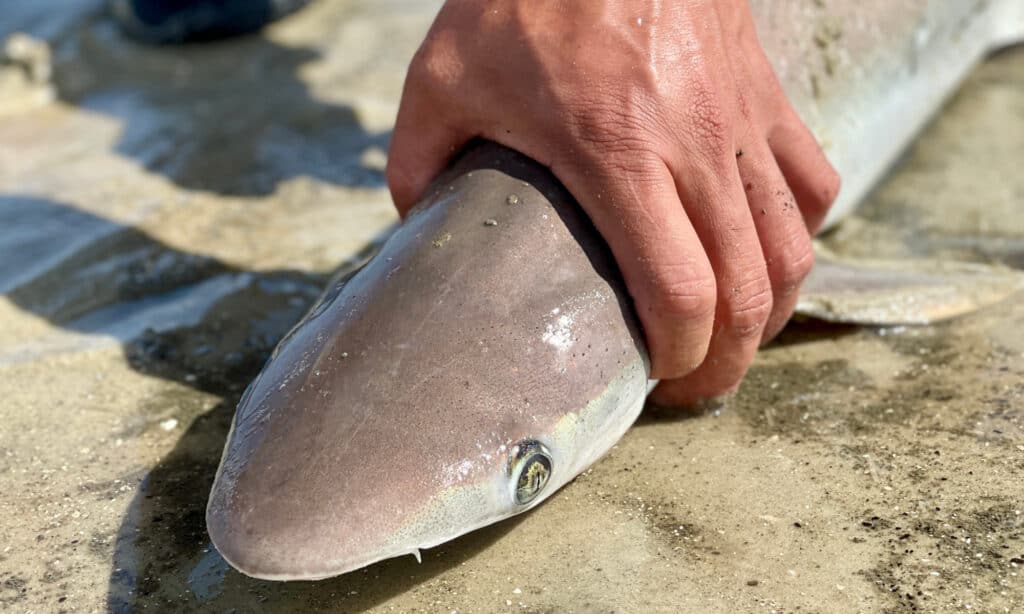
The tiny Atlantic sharpnose shark poses little threat to humans in Buzzards Bay.
©Finley Del/Shutterstock.com
Atlantic sharpnose sharks live more typically in warm, tropical, and subtropical waters. But these sharks have been known to make their way around Buzzards Bay. Two primary stocks exist, one in the Atlantic Ocean and the other in the Gulf of Mexico. The sharks are plentiful, so often enjoyed as a sportfish.
Atlantic sharpnose sharks have streamlined, smaller bodies and, you guessed it, pointy snouts. They come in a variety of gray shades, with white undersides, and white spots on the sides of adults. These sharks also have markings along the edges of their pectoral find. Young sharpnose sharks have black on their dorsal and caudal fin edges.
These sharks grow up to 32 inches long, meaning they’re pretty small (less than 3 feet long) and aren’t particularly dangerous to humans. These small sharks frequently live up to 18 years. Atlantic sharpnose sharks may be in deep water but prefer shallow waters under 32 feet deep, which means you may well spot one of them while out swimming or snorkeling in Buzzards Bay.
8. Smooth Dogfish
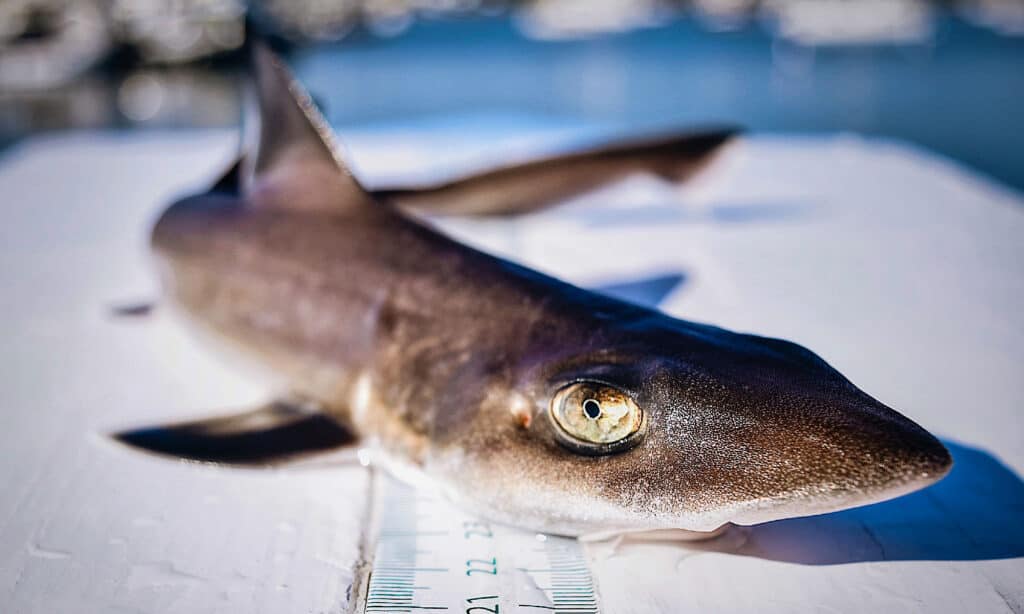
Another tiny shark, the smooth dogfish isn’t going to cause trouble for humans in Buzzards Bay.
©Rafeed Hussain/Shutterstock.com
Known by dusky smooth-hound, smooth dogfish, Atlantic smooth dogfish, nurse shark, or dog shark, these fish belong to the Triakidae family in the hound-shark species. The shark comes in olive gray to brown, with some yellow to gray-white accents. Males have shorter lifespans, up to 10 years, while the females live up to 16 years.
These sharks prefer brackish or marine water, while bottom-dwelling. This means they may reach closer to shore than many other species swimming in Buzzards Bay. They’re relatively small and slender, so not as often seen as a threat by swimmers. However, there are an estimated 10,000 of these fish in Buzzards Bay, eating some 60,000 lobsters annually. They don’t pose specific threats to humans, but they certainly are pests and may cause issues for fishers in the bay.
9. Blacktip Sharks

Blacktip sharks swim close to shore in Buzzards Bay. They’re not particularly dangerous to humans, but take precautions and keep away.
©Gino Santa Maria/Shutterstock.com
One type of shark you could encounter on Buzzards Bay, or elsewhere near Cape Cod, is the blacktip shark. This shark makes its home in tropical and subtropical waters. Still, they can also happily survive and thrive in brackish water in northern climates during summertime.
Also known as black fin sharks, these creatures enjoy wide distribution worldwide and live in a variety of water types. This Buzzards Bay species has developed distinct looks. However, they all share some characteristics. These shared characteristics include the fish having stouts and black tips on the very ends of all its fins. Plus, when these sharks hunt, they will jump into schools of fish to try and grab a meal during the chaos.
Like their bigger cousins, black tip sharks aren’t safe animals to play with, despite their size and seeming timidity. There have been credible reports of this shark species attacking people. This fish is typically shy around people, but people with food may become targets. The best way to avoid agitating this shark is by not going near it at all, or you may become a walking buffet.
10. Bull Sharks
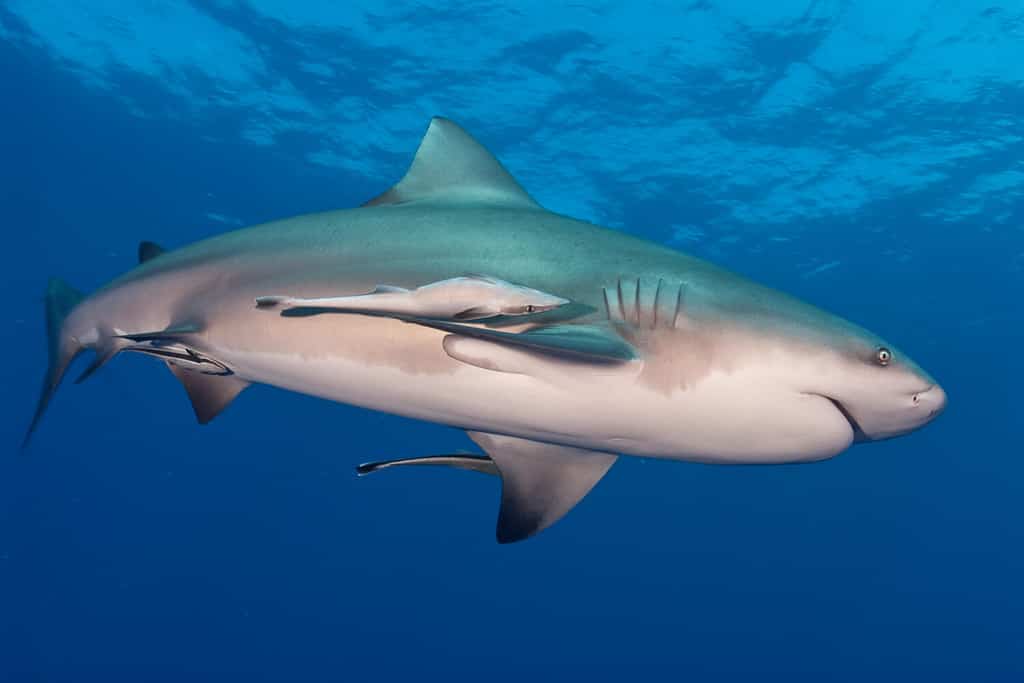
One of the larger and more aggressive species, bull sharks should definitely be avoided in Buzzards Bay.
©Fiona Ayerst/Shutterstock.com
Commonly found worldwide in warmer waters, the bull shark makes its way into Buzzards Bay in summertime. They prefer shallow brackish water and freshwater estuaries, making the Bay the perfect locale for these fishy beasts. They’re part of the requiem shark grouping, meaning they both give live births and migrate.
Bull sharks’ aggressive nature is part of how they’ve come by their name. And their numbers have dropped around the world because of it. Shark-culling occurs frequently in beach areas to protect swimmers, and that means bull sharks are hunted down. They’ve been placed on the IUCN Red List, though, meaning they may no longer be culled legally.
Bull sharks have also been known to travel up rivers such as the Mississippi, as far away from ocean waters as 700 miles (to Alton, Illinois). Bull sharks are most commonly responsible for nearshore shark attacks on humans. You definitely don’t want to be anywhere near these guys.
11. Blue Sharks
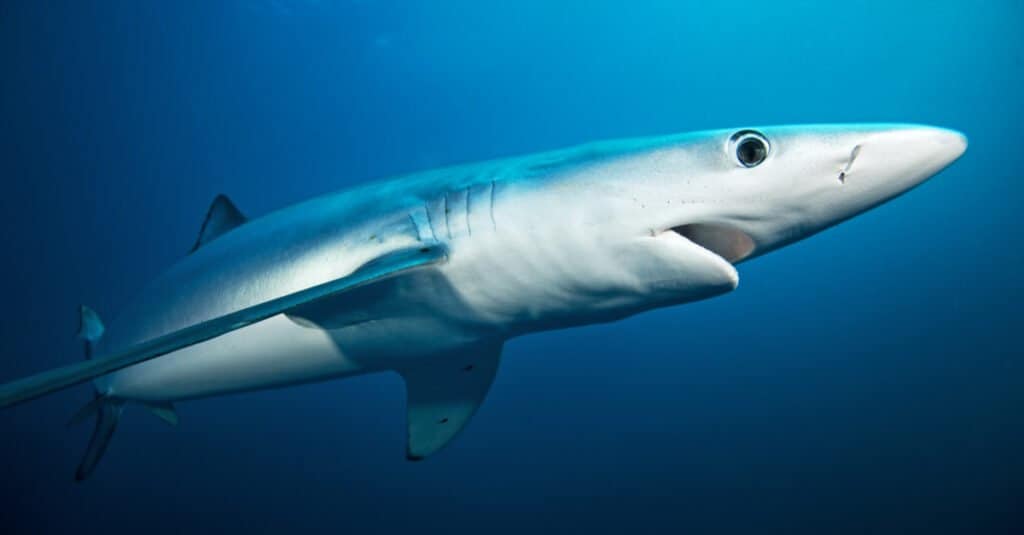
Though not aggressive, blue sharks are sometimes referred to as the “wolves of the sea,” perhaps because they travel at such high speeds. You’ll want to keep away from this species in Buzzards Bay.
©Martin Prochazkacz/Shutterstock.com
One of the most common shark species in the world, blue sharks may be found in almost any large body of saltwater in the world. These large fish filled with terrifying teeth make Buzzards Bay their summer home every year.
Growing up to 12 feet long, blue sharks earn their species name from the blue-to-gray coloration they bear. They feed mainly on fish and squid within the bay and generally aren’t considered aggressive. In fact, they tend to stay away from humans in most cases and almost no known attacks have been reported. Four confirmed fatal attacks exist, with only 25 more non-fatal attacks on record. Even so, you should avoid these sharks as they are predators.
Swimmers Beware
While shark attacks rarely occur, it’s still wise to apply caution when you dive into the waters of Buzzards Bay. Always use safety measures and pay attention as you swim.
- Swim in areas patrolled by lifeguards.
- Never swim alone.
- Always pay attention to posted warnings or advisories. You may want to check in on advisory apps, as well, to ensure you’ve got the latest information on the bay.
- Avoid wearing shiny jewelry or swimsuits while swimming.
Summary of 11 Sharks Found in Buzzards Bay
Here are the 11 different species of sharks found in Buzzards Bay:
| Shark Species | |
|---|---|
| 1 | Sand Tiger Sharks |
| 2 | Spiny Dogfish |
| 3 | Basking Sharks |
| 4 | Great White Sharks |
| 5 | Sandbar Sharks |
| 6 | Thresher Sharks |
| 7 | Atlantic Sharpnose Sharks |
| 8 | Smooth Dogfish |
| 9 | Blacktip Sharks |
| 10 | Bull Sharks |
| 11 | Blue Sharks |
The photo featured at the top of this post is © HikeAndShoot/Shutterstock.com
Thank you for reading! Have some feedback for us? Contact the AZ Animals editorial team.







